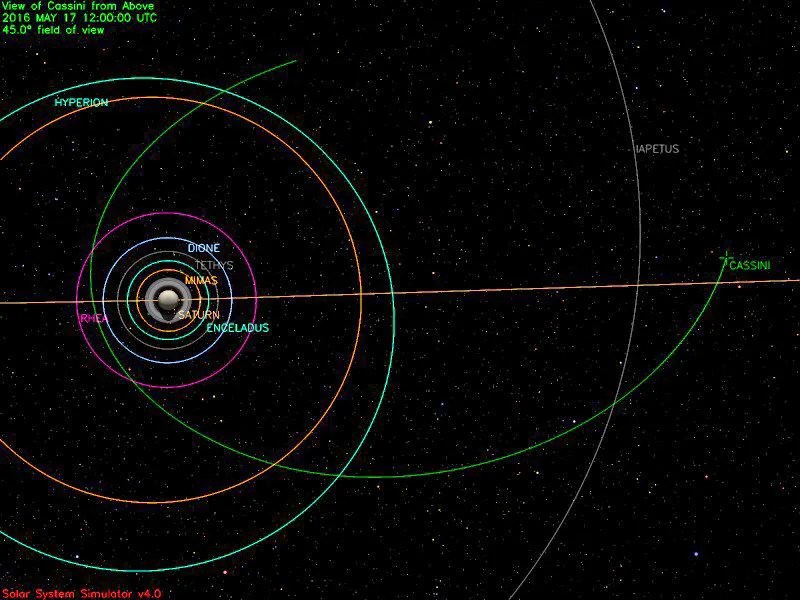Cassini is orbiting Saturn with a period of 31.9 days in a plane inclined 36 degrees from the planet's equatorial plane. The most recent spacecraft tracking and telemetry data were obtained on May 18, using one of the 34-meter diameter Deep Space Network stations in Australia. The spacecraft continues to be in an excellent state of health with all of its subsystems operating normally except for the instrument issues described at http://saturn.jpl.nasa.gov/anomalies .
Cassini continued climbing outbound from Saturn this week towards a May 20 apoapsis, having swept past Saturn's largest moon Titan on May 6. The spacecraft's new orbital inclination, thanks to the Titan T-119 flyby, is a little closer to its target inclination for a spectacular "retirement" next year.
Wednesday, May 11 (DOY 132)
Today, the Imaging Science Subsystem (ISS) continued a 37-hour observation of Saturn's small, dark, irregular moon Skathi that it had begun the day before.
Thursday, May 12 (DOY 133)
ISS completed its allocated time with Skathi, and handed the reins of attitude control over to the Composite Infrared Spectrometer (CIRS). With ISS and the Visible and Infrared Mapping Spectrometer (VIMS) riding along, CIRS began a 23-hour-long examination of Saturn, mapping the planet at mid-infrared wavelengths to determine upper troposphere and tropopause temperatures.
Friday, May 13 (DOY 134)
ISS made a 2-minute storm-watch observation on Saturn. Next, CIRS, with VIMS and the Ultraviolet Imaging Spectrograph (UVIS) stared at the sunlit side of Saturn's rings for an hour to obtain thermal infrared spectra for use in studying ring particle composition.
Saturday, May 14 (DOY 135)
ISS performed a 60-minute observation as part of the satellite orbit campaign, looking at small objects near the planet, with CIRS and VIMS riding along. Following this, ISS carried out another 2-minute storm-watch observation on Saturn.
Sunday, May 15 (DOY 136)
The Magnetospheric and Plasma Science (MAPS) instruments continued collecting data about the in-situ environment today.
Monday, May 16 (DOY 137)
ISS, CIRS and VIMS turned back towards Titan for a 90-minute observation in the Titan monitoring campaign. Ten days after the T-119 close encounter, the distance to Titan was now 4.3 million kilometers. Following this, the Cosmic Dust Analyzer (CDA) began 27 hours of observations as part of the exogenous dust campaign.
This week's featured image catches Saturn's moon Prometheus in the act of causing variations in the narrow, ever-changing F ring: /resources/17375 .
Tuesday, May 17 (DOY 138)
While CDA continued its observations uninterrupted, a high-energy particle known as a galactic cosmic ray (GCR), most likely, happened to slam into Cassini late today, hitting one of its on-board electronic switches. As Cassini reported in telemetry, the impact set one of the solid-state power (SSPS) switch's 192 electrical lines to the "tripped" condition, interrupting power on one of two lines serving an attitude-control Reaction Wheel Assembly (RWA-2). On-board fault-protection software set the switch from the "tripped" state to "off" as it was designed to do. Since the RWAs each have two separate supply lines from the SSPS, there was no effect to Cassini's Attitude and Articulation Control Subsystem (AACS). The flight team would set the line back on via subsequent real-time commanding. This was the 37th occurrence of an SSPS trip during Cassini's flight.
The Deep Space Network communicated with and tracked Cassini on four occasions this week, using stations in Australia. A total of eight individual commands were uplinked, and about 700 megabytes of telemetry data were downlinked and captured at rates as high as 142,201 bits per second.
This image shows Cassini's position on May 17, 2016.
































